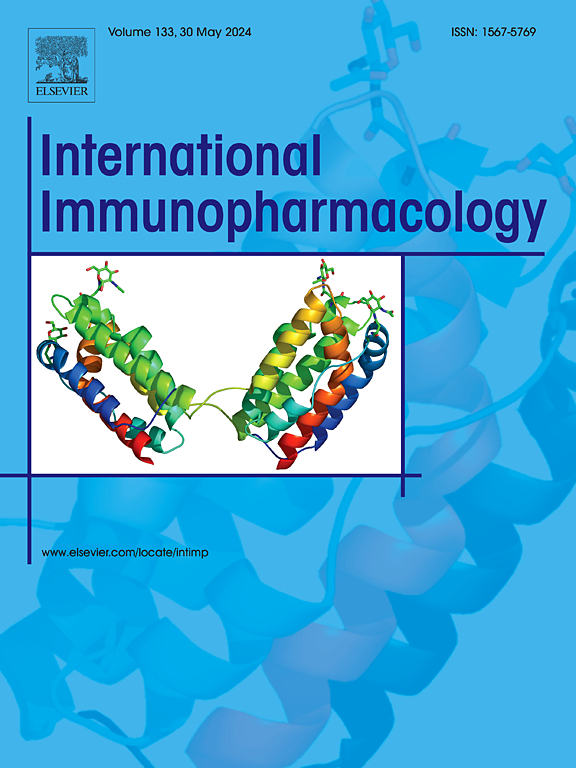Synergistic and mechanistic effects of neogambogic acid in enhancing almonertinib sensitivity in non-small cell lung cancer
IF 4.8
2区 医学
Q2 IMMUNOLOGY
引用次数: 0
Abstract
Non-small cell lung cancer (NSCLC) is characterized by a complex pathogenesis and high mortality. Targeted drug therapy represents a precise method of treatment. However, Improving sensitivity to targeted agents is currently a major challenge in clinical tumor therapy. Neogambogic acid (NGA), a bioactive compound isolated from the Traditional Chinese Medicine (TCM) Gamboge, has shown potential in NSCLC treatment. Nonetheless, the mechanism by which NGA enhances the sensitivity of NSCLC to the targeted drug Almonertinib remains unclear. This study aimed to elucidate the mechanisms underlying the ability of NGA to enhance the sensitivity of NSCLC to Almonertinib, revealing the synergistic effect exerted by the combination therapy. We established a subcutaneous grafted tumor model of mouse lung cancer by injecting Lewis cells, and evaluated the therapeutic efficacy in vivo. The study demonstrated that NGA combined with Almonertinib effectively suppressed NSCLC tumor growth by promoting cancer cell apoptosis and reducing serum tumor marker levels. In vitro experiments revealed that this combination synergistically inhibited lung cancer cell proliferation and induced apoptosis. Mechanistically, NGA demonstrated the ability to bind to Pregnane X receptor (PXR), regulating the expression of drug-metabolizing enzymes and transporters. We further validated this effect using PXR agonists and inhibitors in A549 cells. Additionally, the combination of NGA with Almonertinib significantly inhibited aberrant EGFR activation and downstream PI3K/AKT signaling, leading to enhanced apoptosis. This study demonstrated that the combination of NGA and Almonertinib inhibited the expression of CYP3A4, P-gp, and BCRP via PXR modulation. Meanwhile, it inhibited the EGFR/PI3K/AKT pathway and enhanced the sensitivity of NSCLC to Almonertinib, exerting synergistic anti-tumor effects. Our findings suggest a promising strategy for integrating active TCM components with targeted therapy in NSCLC management.
新藤本酸在非小细胞肺癌中增强阿尔莫那替尼敏感性的协同作用和机制作用
非小细胞肺癌(NSCLC)具有发病复杂、死亡率高的特点。靶向药物治疗是一种精确的治疗方法。然而,提高对靶向药物的敏感性是目前临床肿瘤治疗的主要挑战。新藤黄酸(NGA)是一种从中药藤黄中分离出来的生物活性化合物,在治疗非小细胞肺癌中具有潜在的应用价值。尽管如此,NGA增强NSCLC对靶向药物Almonertinib敏感性的机制仍不清楚。本研究旨在阐明NGA增强NSCLC对Almonertinib敏感性的机制,揭示联合治疗的协同效应。我们通过注射Lewis细胞建立小鼠肺癌皮下移植肿瘤模型,并在体内评价其治疗效果。研究表明,NGA联合Almonertinib通过促进癌细胞凋亡和降低血清肿瘤标志物水平,有效抑制NSCLC肿瘤生长。体外实验表明,该组合具有协同抑制肺癌细胞增殖和诱导凋亡的作用。从机制上讲,NGA能够与孕烷X受体(PXR)结合,调节药物代谢酶和转运蛋白的表达。我们在A549细胞中使用PXR激动剂和抑制剂进一步验证了这种效应。此外,NGA联合Almonertinib可显著抑制异常EGFR激活和下游PI3K/AKT信号传导,导致细胞凋亡增强。本研究表明,NGA和Almonertinib联合使用通过PXR调节抑制CYP3A4、P-gp和BCRP的表达。同时抑制EGFR/PI3K/AKT通路,增强NSCLC对Almonertinib的敏感性,发挥协同抗肿瘤作用。我们的研究结果表明,将中药活性成分与靶向治疗结合起来治疗非小细胞肺癌是一种很有前景的策略。
本文章由计算机程序翻译,如有差异,请以英文原文为准。
求助全文
约1分钟内获得全文
求助全文
来源期刊
CiteScore
8.40
自引率
3.60%
发文量
935
审稿时长
53 days
期刊介绍:
International Immunopharmacology is the primary vehicle for the publication of original research papers pertinent to the overlapping areas of immunology, pharmacology, cytokine biology, immunotherapy, immunopathology and immunotoxicology. Review articles that encompass these subjects are also welcome.
The subject material appropriate for submission includes:
• Clinical studies employing immunotherapy of any type including the use of: bacterial and chemical agents; thymic hormones, interferon, lymphokines, etc., in transplantation and diseases such as cancer, immunodeficiency, chronic infection and allergic, inflammatory or autoimmune disorders.
• Studies on the mechanisms of action of these agents for specific parameters of immune competence as well as the overall clinical state.
• Pre-clinical animal studies and in vitro studies on mechanisms of action with immunopotentiators, immunomodulators, immunoadjuvants and other pharmacological agents active on cells participating in immune or allergic responses.
• Pharmacological compounds, microbial products and toxicological agents that affect the lymphoid system, and their mechanisms of action.
• Agents that activate genes or modify transcription and translation within the immune response.
• Substances activated, generated, or released through immunologic or related pathways that are pharmacologically active.
• Production, function and regulation of cytokines and their receptors.
• Classical pharmacological studies on the effects of chemokines and bioactive factors released during immunological reactions.

 求助内容:
求助内容: 应助结果提醒方式:
应助结果提醒方式:


